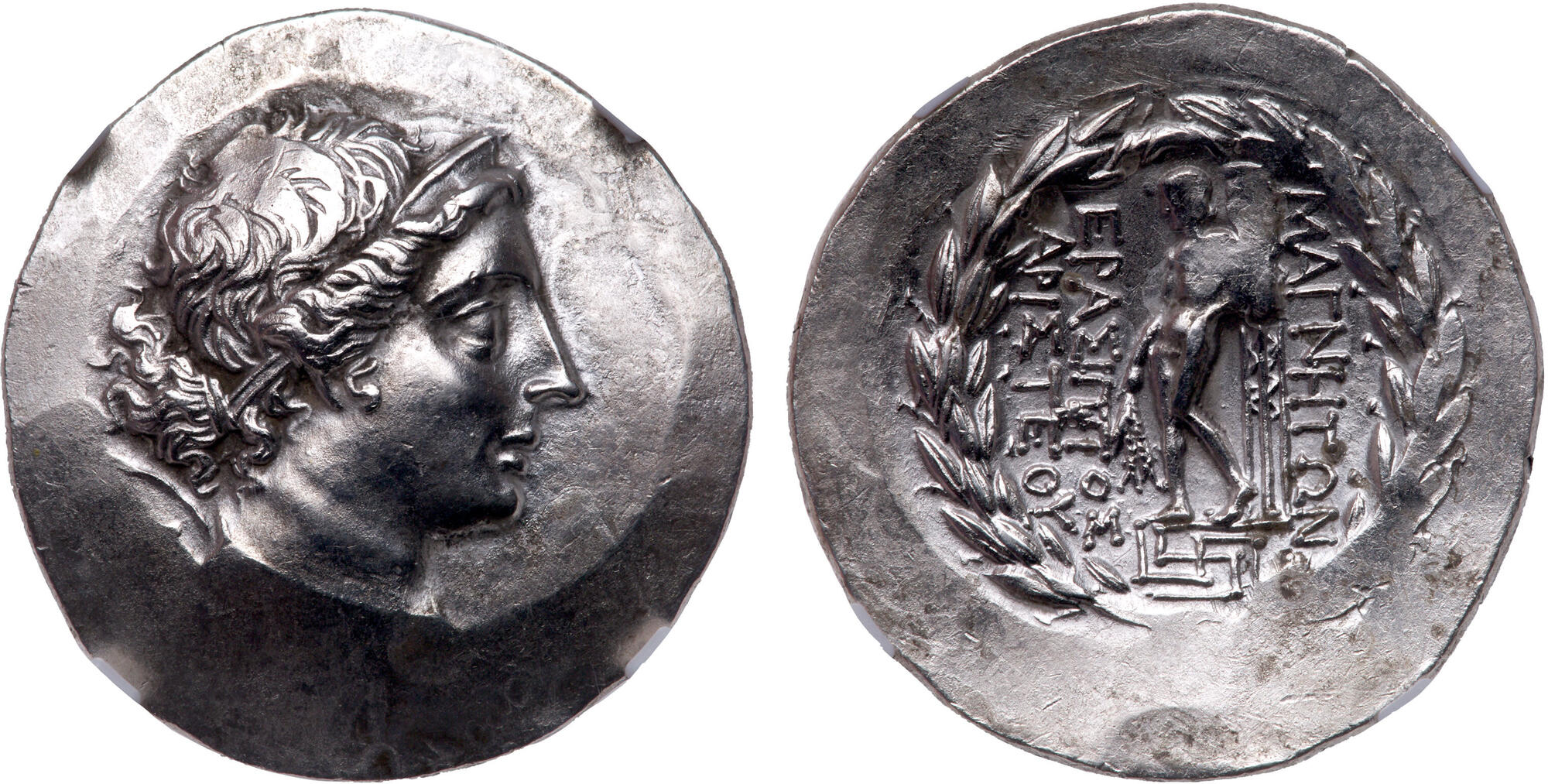Magnesia ad Maeandrum, silver, tetradrachms (155-140 BCE) Jones
From SILVER
155 BCE - 140 BCE Silver 12,742 kg
Description
| ObverseInscription or printing placed on the obverse.: | Diademed and draped bust of Artemis right, bow and quiver at shoulder. |
| ReverseInscription or printing placed on the reverse.: | MAΓΝΗTΩN (Greek).MAΓNHTΩN, Apollo Delphios standing left, holding filleted branch and resting elbow on tall tripod behind, EPAΣIΠΠOΣ/APIΣTEOY in two lines to left, maeander pattern below, all within laurel wreath. |
Mint and issuing power
| MintIdentifies the place of manufacture or issue of a numismatic object.: | Magnesia ad Maeandrum | Ancient regionAncient region.: | Ionia | Modern countryModern country: Turkey | AuthorityIdentifies the issuing power. The authority can be "pretended" when the name or the portrait of X is on the coin but he/she was not the issuing power. It can also be "uncertain" when there is no mention of X on the coin but he/she was the issuing power according to the historical sources: | Attalid Kingdom |
Chronology
| FromIdentifies the initial date in a range assigned in a numismatic context. | 155 BCE | toIdentifies the final date in a range assigned in a numismatic context.. | 140 BCE | PeriodTime period of the numismatic object.: Hellenistic 323-30 BC |
Physical description
| MetalThe physical material (usually metal) from which an object is made.: | Silver |
Median weightMedian of the weights of numismatic objects (in grams). in grams | 16.70 | DenominationTerm indicating the value of a numismatic object. Examples: tetradrachm, chalkous, denarius.: | tetradrachm |
StandardStandard.: | Attic |
Image

H222 Artemis.jpeg [1]
References
| Die study referencePublication of the study: | Jones 19791Jones 1979 | ||
| Coin series referenceReference to coin series study: | Sear II2Sear II, n° 4485, RQEMH3RQEMH, n° 222 | ||
| Coin series web referenceCoin series web references: | |||
Obverse dies distribution
| FrequencyFrequency of specimen in distribution. ᵖ | Number of obversesNumber of obverse dies. ᵖ (o) | % (o) | Number of coinsNumber of coins. (n) | % (n) | Die nameName(s) of the die(s). |
| 1 | 6 | 16.67 | 6 | 2.48 | 6, 7, 15, 23, 35, 36 |
| 2 | 1 | 2.78 | 2 | 0.83 | 11 |
| 3 | 4 | 11.11 | 12 | 4.96 | 18, 19, 22, 26 |
| 4 | 5 | 13.89 | 20 | 8.26 | 3, 14, 16, 24, 31 |
| 5 | 3 | 8.33 | 15 | 6.2 | 1, 21, 33 |
| 6 | 2 | 5.56 | 12 | 4.96 | 4, 5 |
| 7 | 2 | 5.56 | 14 | 5.79 | 32, 34 |
| 8 | 3 | 8.33 | 24 | 9.92 | 12, 20, 25 |
| 9 | 1 | 2.78 | 9 | 3.72 | 2 |
| 10 | 4 | 11.11 | 40 | 16.53 | 9, 13, 17, 30 |
| 12 | 3 | 8.33 | 36 | 14.88 | 8, 28, 29 |
| 19 | 1 | 2.78 | 19 | 7.85 | 10 |
| 33 | 1 | 2.78 | 33 | 13.64 | 27 |
| Total | 36 of 36 | 100.01 | 242 of 242 | 100.02 |
Reverse dies distribution
no distribution is available
Quantification
| Number of obversesNumber of obverse dies. ᵖ (o) | 36 | Number of singletons (o1)The number of singleton coins. ᵖ | 6 |
| Number of reverse diesNumber of reverse dies. (r) | 142 | Number of coinsNumber of coins. (n) | 242 |
| Coins per obverse dieNumber of coins per obverse die. (n/o) | 6.72 | Coins per reverse dieNumber of coins per reverse die. (n/r) | 1.7 |
| Reverse per obverse ratioRatio of obverse dies divided by reverse dies. (r/o) | 3.94 | Percentage of singletons (o1)number of coins (n) divided by the number of singletons (o1) ᵖ | 16.67 % |
| Original number of dies (O) (Carter 1983 formula)The estimation of the number of coins according to Carter 1983 ᵖ | 38.15 | Coins struck if 20,000 as average productivity per dieCoins made if the average productivity for obverses (according to Carter) is 20,000. ᵖ | 763,000 |
| Original number of dies (O) (Esty 2011 formula)The estimation of the number of coins according to the singleton formula in Esty 2011 ᵖ (O) | 42.29 | Survival rate if 20,000 as average productivity per dieSurvival rate if average productivity is 20,000. ᵖ | 0.00032 |
| Coverage (o = % of O) (Esty 1984 formula)Esty 1984 - coverage (% of O) ᵖ (o = % of O) | 97.52% | Die productivity if survival rate 1/2,000Average productivity if survival rate is 1/2,000. ᵖ | 12,686.76 |
| Weight of silver (in kg) if 20,000 coins per die (O = Carter formula)Carter 1983 * Median weight * 20000 (*10 if gold or electrum) ᵖ | 12,742 kg <br /> 12,742 kg | Die productivity if survival rate 1/5,000Average productivity if survival rate is 1/5,000. ᵖ | 31,716.91 |
Remarks
Most likely two workstations